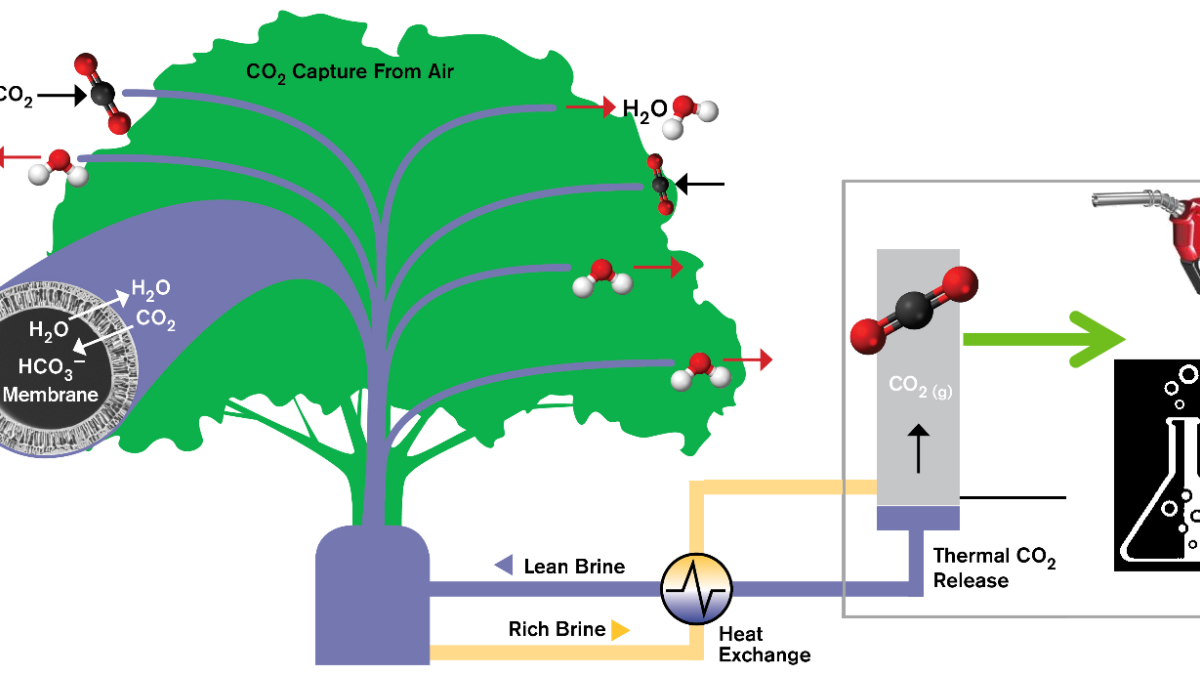ASU, NAU and UT Austin awarded $1.5M from DOE to transform energy technology with new carbon capture concept

Concept for an artificial tree for Mines Air for Fuels and Fine Chemicals (MAFF). Water evaporation through a novel membrane material drives active CO2 pumping from air to within an interior liquid brine. Captured CO2 can be recovered from the brine by heating the CO2-rich brine (yellow) to regenerate a CO2-lean brine (purple) for capturing additional CO2 and forming a CO2-rich gas feedstock (gray) that can be used to produce carbon-neutral fuels and fine chemicals. Image courtesy of Michael Northrop.
Researchers at Arizona State University, in partnership with collaborators at The University of Texas at Austin and Northern Arizona University, have announced $1.5 million in funding from the U.S. Department of Energy’s Advanced Research Projects Agency-Energy (ARPA-E). The research team will demonstrate an entirely new direct air capture (DAC) concept using novel materials to collect low-pressure carbon dioxide from ambient air.
“Cost effectively harnessing unlimited supplies of distributed atmospheric CO2 will significantly expand market opportunities for large fuel, energy storage and fine chemical markets for which bottled or point source CO2 is not currently feasible,” said Matt Green, a principal investigator of the project and an assistant professor of chemical engineering at ASU. “These outcomes could facilitate a circular carbon economy, thus successfully developing this technology would be a groundbreaking achievement.”
The project is a collaboration between researchers from the Ira A. Fulton Schools of Engineering and Biodesign Institute at ASU; the College of Engineering, Informatics, and Applied Sciences at NAU; and the Cockrell School of Engineering at UT Austin.
The research team also includes Klaus Lackner, a professor in the Fulton Schools of Engineering and the Julie Ann Wrigley Global Institute of Sustainability. Lackner is a highly-regarded expert in carbon capture and directs ASU’s Center for Negative Carbon Emissions. Also part of the ASU team are techno-economic analyst Robert Stirling and project manager Justin Flory from the Biodesign Institute and graduate student Yi Yang from Green’s group.
Benny Freeman, a key collaborator on the project and professor in UT Austin’s McKetta Department of Chemical Engineering, has worked extensively to understand the interconnection between polymer structure, polymer processing and membrane-based separations. Graduate student Alec Bridge from Freeman’s group also is part of the UT Austin team.
“It’s very exciting for our team at UT Austin to have the opportunity to work with our colleagues at ASU to demonstrate scalable manufacturing of membranes for the DAC process,” said Freeman, the Richard B. Curran Centennial Chair in Engineering at UT Austin.
In their project, “Mining Air for Fuels and Fine Chemicals,” or MAFF, the team will use water evaporation to drive CO2 capture, which will decrease emissions and improve the energy efficiency of the capture process. The project will use new polymeric materials to create high-surface area membranes that will continuously and actively pump CO2 against a concentration gradient; the membranes could be deployed into structures resembling artificial trees. The process will capture distributed CO2 emissions that can be sequestered or converted into a wide range of energy-dense fuels, fuel feedstocks or fine chemicals.
The project also includes mechanical engineering lecturer Jennifer Wade from Northern Arizona University. She will be responsible for modeling gas transport and exchange across the membrane materials to understand the active pumping process and improve material performance.
The results of the team’s carbon capturing technology will have the potential to help thwart the effects of climate change, provide energy security by facilitating processes to store fuel, and help build a carbon economy by significantly reducing energy costs worldwide.
ASU, NAU and UT Austin received this competitive award from ARPA-E’s OPEN 2018 program, in which teams develop innovative technologies to transform the nation’s energy system. OPEN solicitations are an open call to scientists and engineers for technologies across the entire scope of ARPA-E’s energy mission.
For additional information about the project, contact principal investigator Matthew Green at mdgreen8@asu.edu.
More Science and technology

ASU postdoctoral researcher leads initiative to support graduate student mental health
Olivia Davis had firsthand experience with anxiety and OCD before she entered grad school. Then, during the pandemic and as a…

ASU graduate student researching interplay between family dynamics, ADHD
The symptoms of attention deficit hyperactivity disorder (ADHD) — which include daydreaming, making careless mistakes or taking…

Will this antibiotic work? ASU scientists develop rapid bacterial tests
Bacteria multiply at an astonishing rate, sometimes doubling in number in under four minutes. Imagine a doctor faced with a…